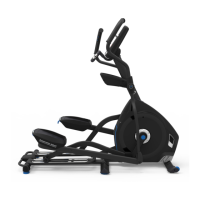30
Remote Heart Rate Monitor
Monitoring your Heart Rate is one of the best procedures to control the
LQWHQVLW\RI\RXUH[HUFLVH7KH&RQVROHFDQUHDGWHOHPHWU\+5VLJQDOVIURP
a Heart Rate Chest Strap Transmitter that operates in the 4.5kHz - 5.5kHz
range.
Note: The heart rate chest strap must be an uncoded heart rate strap from
Polar Electro or an uncoded POLAR
®
compatible model. (Coded
POLAR
®
heart rate straps such as POLAR
®
OwnCode
®
chest
straps will not work with this equipment.) Though your machine is
Bluetooth
®
enabled, it is unable to receive input from a Bluetooth
®
enabled strap or other device.
If you have a pacemaker or other implanted electronic device,
consult your doctor before using a wireless chest strap or other
telemetric heart rate monitor.
NOTICE: To prevent interference with the telemetry HR receiver, do not place any personal electronic devices in the left
side of the media tray.*
Contact Heart Rate Sensors
Contact Heart Rate (CHR) sensors send your heart rate signals to the Console. The CHR sensors are the stainless steel
parts of the Handlebars. To use, put your hands comfortably around the sensors. Be sure that your hands touch both the
WRSDQGWKHERWWRPRIWKHVHQVRUV+ROG¿UPEXWQRWWRRWLJKWRUORRVH%RWKKDQGVPXVWPDNHFRQWDFWZLWKWKHVHQVRUVIRU
the Console to detect a pulse. After the Console detects four stable pulse signals, your initial pulse rate will be shown.
Once the Console has your initial heart rate, do not move or shift your hands for 10 to 15 seconds. The Console will now
YDOLGDWHWKHKHDUWUDWH0DQ\IDFWRUVLQÀXHQFHWKHDELOLW\RIWKHVHQVRUVWRGHWHFW\RXUKHDUWUDWHVLJQDO
• Movement of the upper body muscles (including arms) produces an electrical signal (muscle artifact) that can interfere
with pulse detection. Slight hand movement while in contact with the sensors can also produce interference.
• Calluses and hand lotion may act as an insulating layer to reduce the signal strength.
• Some Electrocardiogram (EKG) signals generated by individuals are not strong enough to be detected by the sensors.
• 7KHSUR[LPLW\RIRWKHUHOHFWURQLFPDFKLQHVFDQJHQHUDWHLQWHUIHUHQFH
,I\RXUKHDUWUDWHVLJQDOHYHUVHHPVHUUDWLFDIWHUYDOLGDWLRQZLSHRႇ\RXUKDQGVDQGWKHVHQVRUVDQGWU\DJDLQ
Heart Rate Calculations
<RXUPD[LPXPKHDUWUDWHXVXDOO\GHFUHDVHVIURP%HDWV3HU0LQXWH%30LQFKLOGKRRGWRDSSUR[LPDWHO\%30E\
DJH7KLVIDOOLQKHDUWUDWHLVXVXDOO\OLQHDUGHFUHDVLQJE\DSSUR[LPDWHO\RQH%30IRUHDFK\HDU7KHUHLVQRLQGLFDWLRQ
WKDWWUDLQLQJLQÀXHQFHVWKHGHFUHDVHLQPD[LPXPKHDUWUDWH,QGLYLGXDOVRIWKHVDPHDJHFRXOGKDYHGLႇHUHQWPD[LPXP
KHDUWUDWHV,WLVPRUHDFFXUDWHWR¿QGWKLVYDOXHE\FRPSOHWLQJDVWUHVVWHVWWKDQE\XVLQJDQDJHUHODWHGIRUPXOD
<RXUDWUHVWKHDUWUDWHLVLQÀXHQFHGE\HQGXUDQFHWUDLQLQJ7KHW\SLFDODGXOWKDVDQDWUHVWKHDUWUDWHRIDSSUR[LPDWHO\
BPM, whereas highly trained runners may have readings of 40 BPM or lower.
7KH+HDUW5DWHWDEOHLVDQHVWLPDWHRIZKDW+HDUW5DWH=RQH+5=LVHႇHFWLYHWREXUQIDWDQGLPSURYH\RXUFDUGLRYDV-
cular system. Physical conditions vary, therefore your individual HRZ could be several beats higher or lower than what is
shown.
7KHPRVWHႈFLHQWSURFHGXUHWREXUQIDWGXULQJH[HUFLVHLVWRVWDUWDWDVORZSDFHDQGJUDGXDOO\LQFUHDVH\RXULQWHQVLW\
XQWLO\RXUKHDUWUDWHUHDFKHVEHWZHHQ±RI\RXUPD[LPXPKHDUWUDWH&RQWLQXHDWWKDWSDFHNHHSLQJ\RXUKHDUW
*

